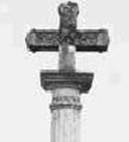bt Sergey Smelyakov & Jan Wicherink
| | ||
Download the article in PDF format
|
1. Introduction
While the world is anticipating the effects of the End of the Maya Long Count Calendar on December 21 2012, they have already started to develop right in front of our eyes.
The Cross, in all its forms, presents the most ancient symbol, and a series of meanings stands behind each of them (See Supplement 1). Some of these meanings are not widely known until our days; some other ones are still veiling the ancient esoteric concepts. The meaning of the majority of these corresponds to astronomical facts and evolution of the Earth and mankind that was kept secret for millennia. But from the 19th century a significant part of these symbols was explained – partly due to the disclosing of the Ancient Knowledge in works of Helen Blavatsky, – partly due to the progress of the sciences. For this reason we may suggest that this disclosure, by itself, presents great importance defining the last two centuries as the age of great revelations; if so, we may expect that they are given purposefully, in order to prepare us for something important.
And we actually see this from a series of independent studies that the current decades can be characterised as the outstanding ones over the millennia; a series of seldom Space phenomena and the End of the Mayan calendar are evidently between them.
In 1996, the concept of the Solar System Zodiac (SZ) was developed as a natural affiliate to the Tropical Zodiac (TZ). By comparing these Zodiacs we see that at present days the Tropical Vernal Point comes to the sign of Capricorn in the SZ, and vice versa (Fig. 7). The obtained conclusion has allowed us to find the explanation for a wide spectrum of important world trends in Nature and society [1, Part 8].
In continuation of the previous studies devoted to (i) astronomical and esoterical analysis of the current decade with the use of the concept of the Zodiac and (ii) revealing of the concept of Time incorporated in the Ankh (the most Sacred Cross of the ancient Egypt) and the King's Chamber [1, Part 7], we show the direct evidences which reveal seemingly the most important astronomical meaning of the Astronomical Cross and, especially, of the Eight-pointed Cross.
In particular, the results of a comparative analysis are presented which show that bringing of these Zodiacs into physical and geometrical correspondence specifies the XX-correlation being symbolized by the Double Cross ![]() , the elements of which, in various combinations, engender the allied models treating the Galactic Equator at the current age, whereas the precessional coincidence of the axes of these Zodiacs defines the Great Celestial Conjunction – one of the four most prominent Celestial events for the Earth in a Platonic year of 26 000 Tropical years, which is symbolized by the Astronomical Cross
, the elements of which, in various combinations, engender the allied models treating the Galactic Equator at the current age, whereas the precessional coincidence of the axes of these Zodiacs defines the Great Celestial Conjunction – one of the four most prominent Celestial events for the Earth in a Platonic year of 26 000 Tropical years, which is symbolized by the Astronomical Cross ![]() .
.
An overview of the esoteric meaning of the different types of Crosses and detailed calculations are presented in
Supplements 1 and Supplement 2, respectively.
2. Tropical Zodiac, TZ as the Terrestrial Cross
By taking into account that the concepts of the Tropical and Solar Zodiacs are minutely described in [1, Part 8], together with a physical background and verification of the obtained results, in this article we concentrate on new results; the basic properties of these Zodiacs are given for clarity of discussion.
Though the general idea of the Tropical Zodiac is well-known, for the purpose of this study keep in mind the basic aspects of this concept, since it is used for synthesizing its generalization – the Solar System Zodiac (SZ, or Solar Zodiac, for short) instead of considering an uncertain concept of a Sidereal Zodiac.
Principally, the Tropical Zodiac (TZ) is determined by the Ecliptic and (Celestial) Equator.
The Ecliptic is a great circle on the Celestial sphere along which the Sun appears to travel in its journey around the Earth, taking one year to do so (here, the Sun presents the direct Hierarch for the Earth).
The Celestial sphere is an imaginary sphere around the Earth on which the stars in the sky are projected.
The (Celestial) Equator is also a great circle on the Celestial sphere; it lies in the plane being perpendicular to the Earth's own axis of rotation.
The North Pole is the point where the Earth's axis intersects the Celestial sphere in the Northern hemisphere.
Since the rotation axis of the Earth is not perpendicular to the Earth’s orbital plane around the Sun but makes an angle ε of about 23 degrees, known as the Obliquity of the Ecliptic (Fig. 1), the Equator and Ecliptic intersect on the Celestial Sphere. The two opposite points on the Celestial Sphere where they intersect are called (the points of) the Vernal and Autumn Equinoxes; the former one, the Tropical 0 ° point (TVP, or the First Point of Aries), is that where the Sun's path along the Ecliptic crosses the Equator from South to North. The Equinoxes define the start of the spring and autumn seasons when the day and night equal in length (Latin: Aequi = equal, Noctium = night).
The line on the plane of Ecliptic which connects these two points is called the axis of Equinoxes; it presents the intersection of the planes of ecliptic ![]() and Equator
and Equator ![]() .
.
Astronomically, the axis of Solstices presents the projection of the Earth's axis of rotation on the plane of Ecliptic; the respective points on the Ecliptic are called the Winter and Summer Solstices (Latin: Sol = Sun Stitium= stand still). For the Northern Hemisphere they define the moment of the year when the noon Sun has the lowest (highest) elevation. Note that in many mythologies the Winter Solstice is associated with the death and re-birth of Nature and various gods.
Mathematically, these cardinal axes of Solstices and Equinoxes are perpendicular one to another. For this reason they form a perfect cross on the plane of Ecliptic; call it the Terrestrial Cross.
This cross, as well as its cardinal points are of great importance in astrology: every object that arrives at any of these points acquires especial importance.
The examples which show the physical importance of the cardinal axes of the TZ are given in [1, Part 8], whereas the esoterical significance of these axes is described in Supplement 1.
By its structure, the sphere of influence of the Tropical Zodiac (TZ) is initially limited to the Earth: it is associated with the aura envelope of the Earth, through which, as via an inhomogeneous filter, different space objects exert their influence on its internal elements – from separate human beings to social structures and natural processes. The accuracy of parameters defining the mathematical model of the TZ is very high and bounded just by the exactness of astronomical measurements that specify the Earth’s orientation and orbit by the Equator and Ecliptic planes, respectively. Use of these two planes supplies both astronomy and astrology with conjugate Ecliptical/Equatorial coordinate systems [4] which uniquely define the place of the Celestial objects with respect to the Earth’s orientation in Space (Fig. 1). The first of them is used in astrology and theoretical astronomy, while the latter one is more convenient for astronomical observations as it adjusted to the daily rotation of the Earth.
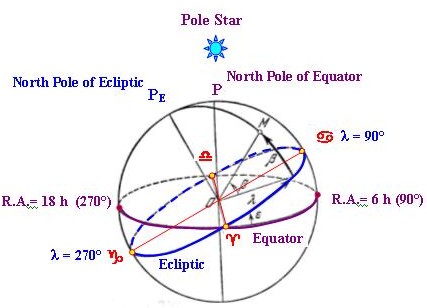
Fig.1. The Equinoxes and Solstices in the Ecliptical coordinate system
The ecliptic longitude λ is measured from the vernal equinox Aries and runs (along the Ecliptic) from 0° to 360° in the same eastward sense as Right Ascension α. As the Equatorial longitude, R.A. can take values between 0 and 360 deg., though more often it is given in time units: hours (h), minutes (m), and seconds (s), where 24 hours correspond to 360 degrees (so that R.A. takes values between 0 and 24 h). Note that the ecliptic longitude of Sun coincides with its Equatorial longitude just at these four cardinal points(![]() ).
).
In its absolute form, the Zodiac is the unity that determines the universal cycle of transformation of energy (along the Ecliptic). This is present in two forms: (1) in static form, when considering separate zones of equal length, and (2) in dynamic form, when the origin and the end merge together, thus generating the fulcrum called the First Point of Aries. But the Entity being contained in it could be divided with the use of different numerological keys – 2, 3, 4, 5, 8, 12, and even 360. Each key defines the concept of dividing the entire cycle into phases and their esoteric meanings. Thus it is commonly accepted (and certified esoterically) that the Zodiac comprising 12 signs most properly reflects the evolutionary stages of the Earth, as shown in the production of trinity and quaternary (viz. spiritual and material, etc.).
Thus with respect to the structure of the TZ – the Terrestrial Cross within the circle of Ecliptic – we can conclude, that the Astronomical cross ![]() (viz. the four-point orthogonal cross within the circle, as well as number 4) actually define its essence.
(viz. the four-point orthogonal cross within the circle, as well as number 4) actually define its essence.
Precession of the Equinoxes and Wobbling of the Ecliptic
Due to the precession of the Equinoxes the Earth's axis makes a complete revolution around the Ecliptic over a period of Platonic year (approximately 26 000 Tropical years). However, it does not describe a circle shown in Fig. 2.a, but one inward turn along a spiral; during this period, the Ecliptic's axis travels several degrees over the celestial sphere (Fig. 3).
As far as the Earth’s rotation and precession do not follow a uniform law, there is no possibility to reliably estimate the precession for an epoch spaced far enough from the period of astronomical observations. For example, the variation in Obliquity over the last 50 years makes -23'' (See Supplement 2).
This means that for an epoch being a cycle of precession apart from the present, the existing approximations lose their consistence. The more so for the precession of the Ecliptic with the Sun's revolution period of 230 million years.
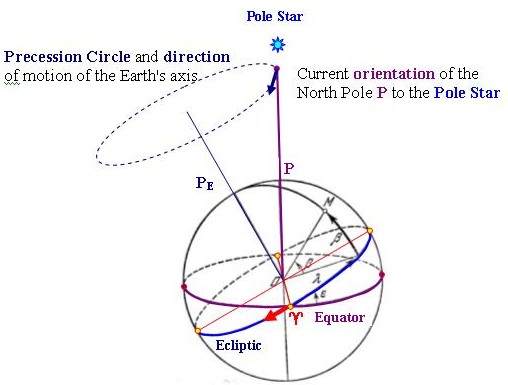
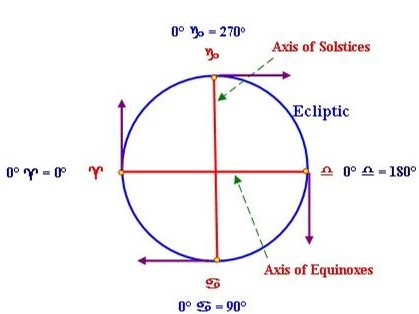
Fig. 2. Precession of the Equinoxes as it is seen on the plane of Ecliptic from the North Pole
- Precession of the Equinoxes as it is seen on the Celestial sphere. The red arrow gives the direction of motion of the Tropical Vernal Point Aries (Origin of TZ) along the Ecliptic;
- The purple arrows show the direction of motion of the Vernal Point Aries and other cardinal points
 along the Ecliptic relative to the "Fixed" stars
along the Ecliptic relative to the "Fixed" stars
The precession of the Terrestrial Cross gives us Swastika (See Fig. 2.b.) as a symbol of the rotating TZ which preserves orthogonality of the cardinal axes and physical importance of the cardinal points.
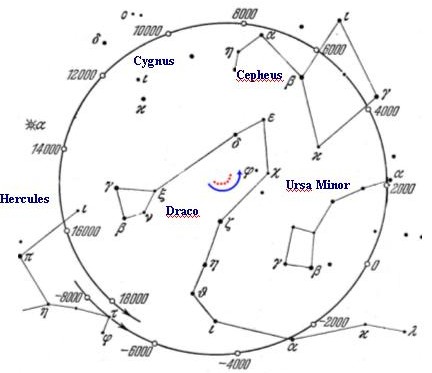
Fig. 3. The Celestial path of the North Pole of Equator over 26 000 years (from 8 000 BC to 18 000 AD).
For comparison, the path of the North Pole of Ecliptic is given for the same period (red points)
“Fixed Stars” and the Weak Points of the “Eternal” Sidereal Zodiac (SiZ)
The Sidereal Zodiac also presents the circle of Ecliptic, but with a fixed origin. For this reason its cardinal axes have nothing in common with the Solstices and Equinoxes.
When considering or postulating a correlation between the Sidereal Zodiac’s origin and some star, rarely does an author take account of the proper motion of the stars. This motion is significantly less than the precessional correction for the Equatorial coordinate of stars that makes about 50’’ a year. However, a proper motion may be relatively large even for a human’s life. Now, more than 330 stars are known with a proper motion exceeding 1″ a year. Average μ (in seconds of arc per year) for the stars of magnitude of up to magniture 6 is about 0.1″; e.g. μ(Regulus, α Leo) = 0.24″ a year, μ(Sirius, α Canis Major)= 1.32″ a year.
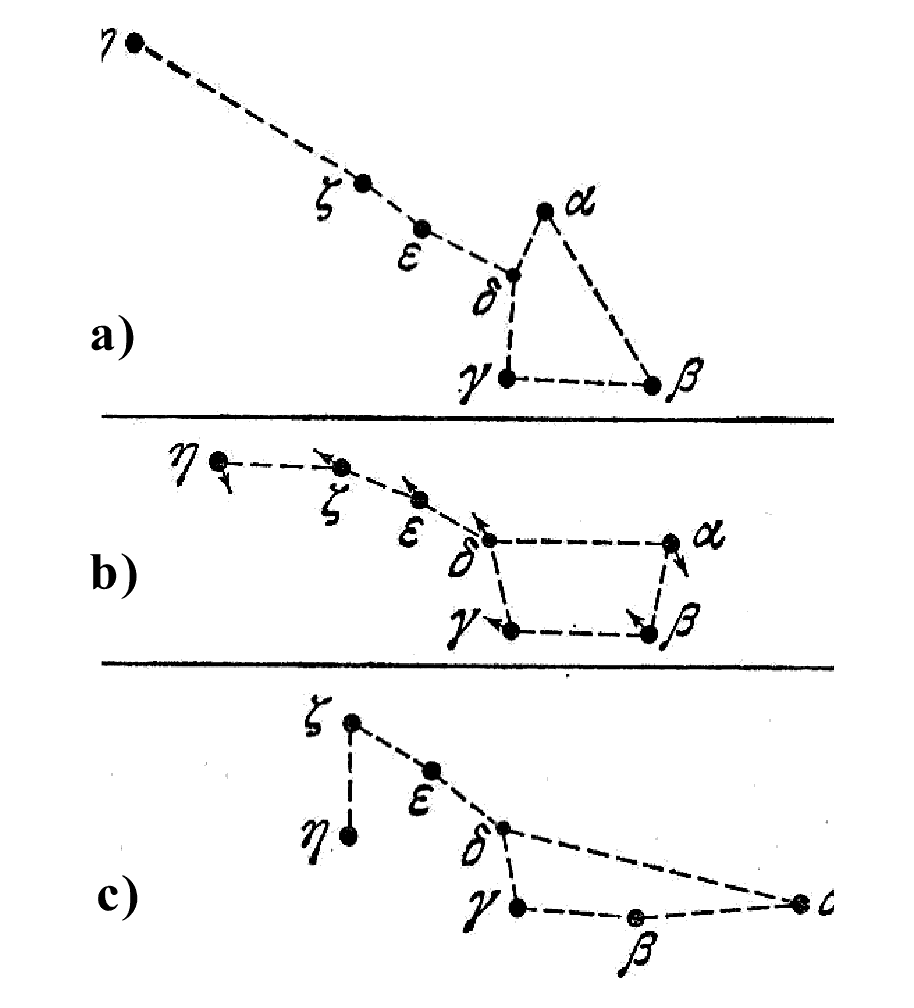
Fig. 4. Change in the image of the Great Bear over 100 000 years
(a) – 50 000 BP, (b) – now, (c) – in 50 000 years
Therefore, not only a Platonic year, but even one zodiacal age causes significant variations in the coordinates of the stars. That is why it makes no sense to consider either the stars, or the boundaries of the constellations for the reference points for such time intervals.
Hence, if some star is chosen to present the “ancient” Sidereal Zodiac's origin, in addition to the uncertain correction to an irregular precession and wobbling of the Ecliptic, we must take account of its proper motion. Who does this? In reality, the considered estimates for the Origin of such Zodiacs differ by dozens of degrees, and even in India, where it is widely used, these estimates differ by as much as a few degrees.
Besides, no consent exists neither with the subject of SiZ's sphere of influence (whether it is Earth, Solar System, or Galaxy), nor with the esoterical meaning of its origin. Moreover, the 0°, 90°, 180° and 270° points of any Sidereal Zodiac DO NOT REFLECT CRITICAL POSITIONS OF THE SUN as the respective (by coordinate) TZ's cardinal points do!
Therefore it is not clear why we should give preference to some uncertain "fixed" point, if a series of actual factors of a physical, mathematical and esoterical natures provide evidence that the current orientation of the Earth does actually reflect the Solar and Space influence. For this reason any SiZ should actually be considered as nothing more than an Ecliptic coordinate system with an arbitrary origin.
By allowing for the Ancient esoterical, geometrical and astronomical considerations being overviewed in Supplement 1 we can conclude the following.
Resume 1.
1. The axes of the Tropical Zodiac are effectual from both physical and esoterical points of view: the Solstice line presents the Ecliptic projection of the Earth's axis of rotation, whereas the line of Equinoxes presents the intersection of the planes of Ecliptic and Equator. To this end the perfect cross ![]() made of these lines, named the Terrestrial Cross, presents the exact replica of the Stauros
made of these lines, named the Terrestrial Cross, presents the exact replica of the Stauros ![]() , or the four-armed, or philosophical cross.
, or the four-armed, or philosophical cross.
2. When the Terrestrial Cross is united with the engendering Ecliptic, the structure ![]() of the TZ becomes the Astronomical cross
of the TZ becomes the Astronomical cross ![]() , or the Cross of the World, or, in other presentation – the Ankh, or Crux ansata
, or the Cross of the World, or, in other presentation – the Ankh, or Crux ansata ![]() .
.
3. By allowing for the direction of rotation of these axes and taking account that they point to the four cardinal points, we obtain the Swastica ![]() , or Decussated cross X.
, or Decussated cross X.
4. By its direct construction, the TZ is reflected by the cross of double glyph ![]() which is presented as the cross of the two equinoxes and the two solstices placed within the figure of the earth's path.
which is presented as the cross of the two equinoxes and the two solstices placed within the figure of the earth's path.
5. Last, but not least are the multiple references to the 0° Capricorn as the point of the Winter Solstice; this means that it was namely the Tropical Zodiac which was considered in the esoteric concepts, because the Sun passes the point 0° Capricorn at Winter Solstice just in the TZ: in any Sidereal Zodiac this point, 0° Capricorn, has nothing in common with this event ("dieing Sun" at the shortest day of the year) except once in 26 000 years.
3. The Solar System Zodiac, SZ , Geometry of Space Influence
As we may see this from a series of sound examples [1, Parts 1, 8], Space matter and objects exert their influence anisotropically, first of all - from definite directions and within definite planes. Within the Solar System, these are basically (i) the plane of Ecliptic ![]() , and (ii) its axis that passes through the North Pole of Ecliptic. For the Earth, the similar objects are: (iii) the plane of Equator
, and (ii) its axis that passes through the North Pole of Ecliptic. For the Earth, the similar objects are: (iii) the plane of Equator ![]() and (iv) the Earth’s axis of rotation,
and (iv) the Earth’s axis of rotation,![]() , that passes through the geographical North Pole (NP) being also the NP for the Equatorial coordinate system.
, that passes through the geographical North Pole (NP) being also the NP for the Equatorial coordinate system.
The axis ![]() and the plane
and the plane ![]() define the basic elements of symmetry both for the Globe and for its Space shield - electromagnetic envelope and radiation layers. In particular, the Geomagnetic field directs the charged Space matter to the Poles (The relevance of the Poles in the Space-Earth interaction is supported by the Secret Doctrine [1, Part 6]).
define the basic elements of symmetry both for the Globe and for its Space shield - electromagnetic envelope and radiation layers. In particular, the Geomagnetic field directs the charged Space matter to the Poles (The relevance of the Poles in the Space-Earth interaction is supported by the Secret Doctrine [1, Part 6]).
Within the Solar System, the Earth and the other planets interact between themselves and the Sun in the plane of Ecliptic. At the same time, all these Heavenly objects experience the same influence, the Galactic Centre and other Galactic objects exert on them, e.g. from the Southern Pole of Ecliptic. From this point of view, the Solar System (SS) as a whole is called the Heliosphere. Hence, the plane of Ecliptic ![]() and its axis also present the basic elements of symmetry for the Solar System through which the outer Space exerts its influence on the interior of the Heliosphere.
and its axis also present the basic elements of symmetry for the Solar System through which the outer Space exerts its influence on the interior of the Heliosphere.
Though the basic interactions within the Solar System is realized in the plane of Ecliptic, the actuality of the Southern direction for the Solar System is also emphasized. As to the Earth, pay attention to its electromagnetic and gas/plasma envelopes and their foci - the Polar regions through which the radiation material (plasma) inflows and discharges, and the electrical nature of the basic interaction mechanism which is a topic for subsequent considerations. Researchers are now insisting more, and more, that the Earth's temperature increases are dependent upon, and directly linked to, space-terrestrial interactions; be it Earth-Sun, Earth-Solar System, and/or Earth-Interstellar.
It is known that electromagnetic interactions play a great part in the interaction of the heavenly bodies. At this, the Sun and comets exert their influence to the Earth through its magnetosphere, and the TZ, by its structure, reflects the mechanism of this interaction.
For example, an analysis [1, Part 8] of the growing discrepancy between the Earth's rotation and magnetic axes shows that (i) the TZ may work now in other ways than it did a few centuries ago, and (ii) the increasing discrepancy can cause instability effects in the Earth processes. (This situation might be likened to a positive feedback that is described by the rise in mechanical wobbling being caused by irregular wear or a broken rotating part: the more the wobble, the more the wear, and vice versa).
Therefore, the Equator and Ecliptic planes, as well as their axes, define the conjugate geometric elements that specify the channels through which the Space exerts its physical influence on the Earth, whereas the Ecliptic defines the plane where the physical interaction between the planets and Sun takes place. As far as these elements define the geometrical structure of the TZ, the line of Equinoxes being specified by the crossing of these planes becomes the focus of this structure, whereas the TZ’s Solstice line presents the projection of the Solar System axis.
Hence, the cardinal points of the Tropical Zodiac and the TZ itself are adjusted to the current orientation of the Globe (that makes them the natural reference points for the Earth) and present the objective “channels”, or most sensitive foci of perception, through which the Space and Solar System’s objects exert their physical influence on the Earth. Therefore, we may conclude that the analogous structure being adjusted to the Solar System peculiarities may describe the foci for the Solar System, which carry out the same function from both the physical and esoterical points of view.
The Concept of the SZ
The whole of the Universe is saturated with the principle of Hierarchy, both esoterically and physically: each system level presents a hierarchical system of being, and retains an element of the whole.
On the one hand, the Solar System presents a vital-mechanical organic entity where the Sun acts as the heart and brain of the Solar World, or Solar sphere [1, Part 6]. Within our hierarchical Solar sphere chain, which includes the Earth, the Heavenly bodies influence the terrestrial objects through the TZ (viz. the Earth’s Aura, or Earth's electromagnetic envelope), but in different ways: if the Solar sphere's objects act directly through the TZ, the energies from outside the Solar sphere are filtered or transformed through the Solar System envelopes, or Aura. The Aural Egg of the Solar System rotates around the axis of the Ecliptic like the Aural Egg of the Globe rotates around the Earth’s axis, whereas both of them revolve around their Hierarchs – the Galactic Centre and Sun, respectively.
On the other hand, the series of Examples [1, Part 8] shows that the geometry of physical interactions between the Galaxy and the Solar System, and between the latter one and the Earth follow the same structural model the elements of which present the foci of physical influence, where the same plane of Ecliptic presents the governing element for the system of the lower level (viz. Earth) and the internal element for the system of the upper level (viz. Galaxy).
Therefore, with respect to the Hermetic axiom, "as above, so below; as below, so above", we cannot exclude the existence of a Solar System Zodiac which carries out the "same" function from the perspective of the Sun, as the TZ does from the perspective of the Earth.
Solar System’s Position in the Galaxy
The general structure of the Galaxy is depicted in Fig. 5.a. It presents a flattened system being symmetrical relative to the basic plane called the Galactic Plane. Intersection of the latter one with the Celestial sphere gives the Galactic equator, which actually coincides with the mean line of the Milky Way.
The Galaxy rotates around its axis passing through the GalacticCenter (GC), the Galactic North Pole (![]() ) of which is projected to the constellation Coma Berenices (Table S2.1).
) of which is projected to the constellation Coma Berenices (Table S2.1).
The Galactic Centre is the rotational center of the Milky Way galaxy. When observed from the Solar System, it is projected to the constellation Sagittarius (Table S2.2).
In their average planes of revolution, being perpendicular to the axis of the Galaxy, the Sun and stars move around the GC so that at any moment the course of each object is perpendicular to the direction of the GC; this revolution is clockwise from the side of the ![]() . As to the Solar System, it completes its revolution around the GC in a Galactic Year which makes approximately 200 – 230 million Earth’s years.
. As to the Solar System, it completes its revolution around the GC in a Galactic Year which makes approximately 200 – 230 million Earth’s years.
Meanwhile, in its local galactic vicinity, the Sun moves (Fig. 5.b) towards the point on the Celestial sphere which is called the Solar apex; at present, it is projected to the constellation Hercules (Table S2.3).
The North Pole of Ecliptic ![]() is projected to the constellation Draco; this point also moves along the Celestial sphere, but very slowly (Fig. 3). Though the plane of Ecliptic is defined by the Earth’s orbital plane, the orbital planes of the massive planets are inclined to the Ecliptic at a relatively small angle: approximately by 0 ° for Uranus and Neptune, 1.3 ° for Jupiter and only for Saturn it makes 2.5 ° . By analogy with the Galactic Equator this allows us to consider the Ecliptic as the Solar System’s Equator which defines the average plane of the Solar System.
is projected to the constellation Draco; this point also moves along the Celestial sphere, but very slowly (Fig. 3). Though the plane of Ecliptic is defined by the Earth’s orbital plane, the orbital planes of the massive planets are inclined to the Ecliptic at a relatively small angle: approximately by 0 ° for Uranus and Neptune, 1.3 ° for Jupiter and only for Saturn it makes 2.5 ° . By analogy with the Galactic Equator this allows us to consider the Ecliptic as the Solar System’s Equator which defines the average plane of the Solar System.
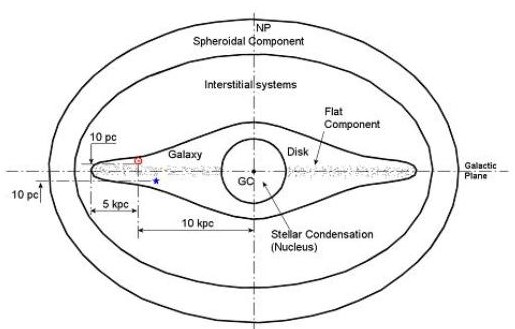
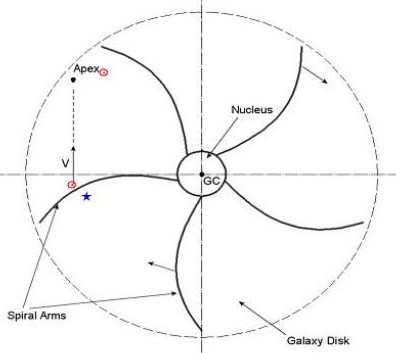
Fig. 5. General structure of the Galaxy with Sun and Eta Carinae (η Car) |
a) Side view: section through the Sun, Galactic Center (GC) and Galactic Poles axis; |
Notes. (i) 1 pc ≈ 3.263 light years ≈ 206 265 astronomical units (a.u.) ≈ 30.8 x 10 ¹² km; |
The Structure of the Solar System’s Zodiac
Describe the structure of the Solar System’s Zodiac (SZ) by resemblance with the Tropical one (applicable to the Earth presenting the element of the Solar System) and with respect to the axiom "as above, so below; as below, so above" applied to the one level higher hierarchy – to the Solar System. In this case the basic SZ elements must relate to the Solar System as the TZ's ones – to the Earth.
Thus since the planets revolve around the Sun in approximately the plane of Sun-Earth Ecliptic ![]() , we take it for the plane of the Solar System’s Equator
, we take it for the plane of the Solar System’s Equator ![]() and call its axis that of the Solar System. Since our Solar System moves in a circular movement around the Galactic Center, we regard the latter the direct Hierarch for the Solar System and take the plane of the Galactic Equator, in which our Solar System revolves around the Galactic Center, for the “Galactic Ecliptic”
and call its axis that of the Solar System. Since our Solar System moves in a circular movement around the Galactic Center, we regard the latter the direct Hierarch for the Solar System and take the plane of the Galactic Equator, in which our Solar System revolves around the Galactic Center, for the “Galactic Ecliptic” ![]() .
.
As in the case with the TZ, the intersection of the planes ![]() and
and ![]() gives the straight line on the Ecliptic plane which defines the axis of Equinoxes Z and Z’ for the SZ. Since the direction to the Galactic North Pole
gives the straight line on the Ecliptic plane which defines the axis of Equinoxes Z and Z’ for the SZ. Since the direction to the Galactic North Pole ![]() is normal to the plane of the Galactic Ecliptic
is normal to the plane of the Galactic Ecliptic ![]() , its projection FF' (Galactic Solstice axis) to the plane of the Solar System Equator (viz. conventional Ecliptic)
, its projection FF' (Galactic Solstice axis) to the plane of the Solar System Equator (viz. conventional Ecliptic) ![]() is perpendicular to the line of intersection ZZ' (Galactic Equinox axis) of these planes and defines the Solstices F and F' for the SZ. It is clear that for the SZ the physical meaning of Equinoxes and Solstices is the same as for the TZ (Fig. 6.a).
is perpendicular to the line of intersection ZZ' (Galactic Equinox axis) of these planes and defines the Solstices F and F' for the SZ. It is clear that for the SZ the physical meaning of Equinoxes and Solstices is the same as for the TZ (Fig. 6.a).
As in the case with the TZ, the cardinal axes of the Solar Zodiac form a perfect cross, both on the plane of the Galactic Equator, and on the plane of Ecliptic; call it the Galactic Cross.
These are those planes and directions through which the Galaxy actually exerts its influence and through which this influence is redistributed:
- as the Sun at a cardinal point defines the start of the respective season of the Terrestrial year, so does the Galactic Centre when it comes to a cardinal point of the Solar Zodiac, but for the Solar System as a whole. Note, that now it is only 3° off SZ's Equinox Z (and the TZ's Winter Solstice as they coincide);
- the projection to the Ecliptic (viz. the Ecliptic longitude λ) of the significant points from the Celestial sphere presents, as the millennia of astrological experience acknowledge, almost the same significance as these points themselves, and therefore these projections are used.
XX-Correlation
As far as the velocity of the TZ’s precession is by several orders of magnitude greater than that for the SZ (over a Platonic year, the Earth’s axis makes a complete circle of 360°, whereas the ![]() shifts by several degrees only), for the current age the cardinal points of the SZ may be considered immobile.
shifts by several degrees only), for the current age the cardinal points of the SZ may be considered immobile.
Since the cardinal points of the SZ are mutually orthogonal and precess synchronously along the Ecliptic with an average speed of 50'' a year, we may unite the Galactic and Terrestrial Crosses into a single concept – XX-correlation. At some moment these two crosses coincide synchronously because each cardinal point of SZ is as distant from the nearest cardinal point of TZ (Fig. 6.a) as the point Z from 0 ° Capricorn..
Therefore, four times a Platonic year, viz. each 6500 years in average, the rotating Galactic Cross coincides with the Terrestrial Cross. Call this event the Great Celestial Conjunction (GCC); one of these events takes place at present; the point and interval estimates (Suppl. 2) for its epoch are as follows
![]() = J1998.3475 or May 7, 1998, (1)
= J1998.3475 or May 7, 1998, (1)
 =
= ![]() ±
± ![]() = J1998.3 ± 19.5 ≈ { 1978.8 , 2017.8 }, (2)
= J1998.3 ± 19.5 ≈ { 1978.8 , 2017.8 }, (2)
![]() =
= ![]() ± 2 X
± 2 X ![]() = J1998.3 ± 2 X 19.5 ≈ { 1959.3 , 2037.3 }. (3)
= J1998.3 ± 2 X 19.5 ≈ { 1959.3 , 2037.3 }. (3)
Meanwhile, although the GCC takes place four times a Platonic year, the importance of the current event may probably be the largest since both the Galactic Centre (the "Sun" for our Solar System) and the Solar Apex longitudes, apart from a series of nebulae (Fig. 6.b) are allocated in the close vicinity of the cardinal point 0° Capricorn = 270° (Tables S2.2, S2.3) whereas the latter point of the TZ presents the "Birth of the Sun", or the origin of the Tropical year. For this reason it may be considered as the Origin of the Platonic year.
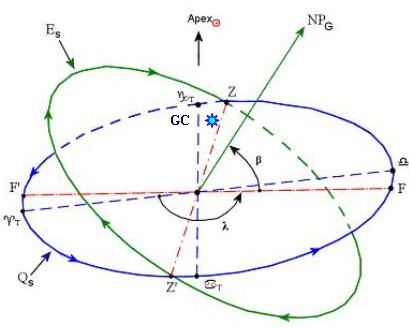
a) Planes and Cardinal Axes of the Solar and Tropical Zodiacs
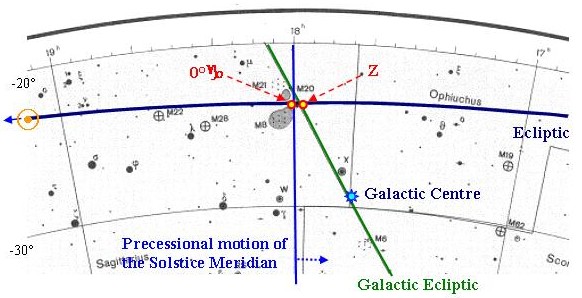
b) Celestial position of the Galactic Ecliptic (shortly before the Great Celestial Conjunction)
(Note that the Celestial map present the sky as it is seen if we look upwards)
Fig. 6. Geometry of the Solar System Zodiac (SZ)
| TZ's cardinal points and axes on the plane of Ecliptic (in Figs.1-2 they are given in red) |
Notes. 1. The angle between the axes ZZ¢ and Solstice axis of TZ makes minutes of arc for the current epoch; it is grossly exaggerated in the diagram for illustrative purpose. | |
The SZ in Reference to TZ
Now, the principal question arises, whether it is the point Z or Z' that have to be taken for the Origin of the SZ. It is the northern hemisphere that provides dominant influence over the Earth [1, Parts 6, 8]. But the Sun's toroidal field and the Solar System as a whole might be likened to a flat circular aerial, which is tuned to both Northern and Southern Hemispheres. However, with respect to the Principle of Hierarchy, the Sun, as the heart and brain of the Solar System [1, Part 6], must first be oriented to its Hierarch, to the Galactic Centre. Since the Sun is located above the Galactic Equator, the Solar System is observed to be North from the GC, relative to the Galaxy's North Pole. Besides, physical observations show definite dominance of the Southern direction in the Space influence (See Example in [1, Part 8]).
This fact, as well as the concentration of the principally important objects (GC, Solar Apex. etc.) in the close vicinity of the SZ's Equinox point Z allows us to suppose that namely this Equinox point should be taken for the "Vernal" point, that is for the Origin of the SZ.
As the universal cycle, any Zodiac allows division by the different key numbers – 4 (elements), 12 (presenting the Signs as 30°-arcs), etc. However, as far as the number 12 presents a universal importance, we can divide (e.g. for convenience of comparison of these two Zodiacs) the SZ into a 12 signs as well. But whatever number of signs we use, or do not use, the SZ’s cardinal points remain orthogonal and retain their principal significance. For this reasons the correspondence between the cardinal points of the TZ and SZ remains correct, whatever SZ's division is used.
Last, but not least is the following. Relative to the point of observation in the Galaxy’s North Pole, the visible traffic direction of the Galactic Centre around the Sun along the Galactic Ecliptic ES is clockwise, while the visible traffic direction of our Sunaround any planet (in the same plane ![]() =
= ![]() ) is anticlockwise. Therefore, in the TZ and SZ the longitudes are incremented in the opposite directions.
) is anticlockwise. Therefore, in the TZ and SZ the longitudes are incremented in the opposite directions.
In order to visualize (Fig. 7) the obtained correspondence between these two Zodiacs, consider the SZ's projection on the Ecliptic against the TZ for the current epoch which follows the GCC of (1).
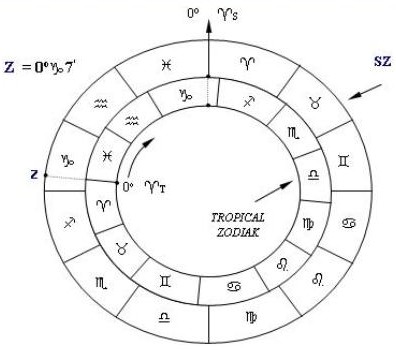
Fig. 7. Tropical (internal ring) and Solar System (external ring) Zodiacs for J2006
The arrow at 0° Aries indicates the direction of actual precessional displacement of the TZ along the SZ after the conjunction of their cardinal axes at the GCC (1). Note that the angle between the respective cardinal points of the TZ and SZ makes several minutes of arc for the current epoch: it is grossly exaggerated for illustrative purpose.
What Influence does the SZ Exert on the Earth?
The most intriguing thing in Fig. 7 is the symmetry in behaviour of the Origins; the First Point of Aries of the SZ (TZ) has completed its path through Sagittarius of TZ (SZ, Resp.) at the GCC (1) and started its travel through the Capricorn (!)
In compliance with the conventional astrological approach, coming of the point of Aries (TZ) to the cusp of a Zodiacal sign means starting of the Age named by this sign. Since the cardinal points of the SZ and TZ has coincided in May 1998 with respect to (1), or have to coincide in the current Era of GCC,  (2) within the Age of Transformations
(2) within the Age of Transformations  (3), we may conclude that transfer to a New Age is under way, but for what Age? The bringing of the SZ into correlation with the TZ (Fig. 7) shows, that the situation is much more surprising than coming to the Age of Aquarius; it rather forced us to submit the following three hypotheses.
(3), we may conclude that transfer to a New Age is under way, but for what Age? The bringing of the SZ into correlation with the TZ (Fig. 7) shows, that the situation is much more surprising than coming to the Age of Aquarius; it rather forced us to submit the following three hypotheses.
Hypothesis SZ-1. The vernal points Aries (SZ) and Aries (TZ) are symmetrically completing their way through the Sagittarius signs (viz. Aries (SZ) through the TZ Sagittarius, and Aries (TZ) through the SZ Sagittarius). This brings us to the end of the Age of Sagittarius, not the Age of Pisces.
Hypothesis SZ-2. The forthcoming age is the Age of Capricorn, since the vernal points Aries (SZ) and Aries (TZ) are symmetrically approaching both the TZ and SZ Capricorn signs, and so, the transfer to the New Age is taking place now – with the coming of the new millennium!
Hypothesis SZ-3. The sign of Aquarius takes on special significance for the Earth, since both the Tropical and the SZ’s signs of Aquarius overlap. This situation might be interpreted as the undistorted (and, hence, magnified) passing of Aquarian energies to Earth, enhanced by the present influence of Uranus.
The arguments in support of these Hypotheses are presented in [1, Part 8]. In general, they demonstrate a synchronism of the Change-of-Ages Concepts and include both astrophysical and historical analysis, as well as esoterical and astrological considerations. In particular, it is shown how the comets arrive in unison with the Solar cycles, and the latter ones – with the oscillation of the hypernova Eta Carinae.
The orthogonality of the SZ and TZ axes at the GCC has evidently caused a change in both the flux and polarities of the energies radiated from the Galaxy to the Earth. To clarify this point, just think what happens when you stick your hand out of the window of a driving car. When you hold your hand orthogonal to the direction of travel of the car, you will get the maximum flux of the wind energy that will be experienced as drag, but when hold your hand parallel to the direction of travel, almost no drag is experienced. This is also why we align a solar panel perpendicular to the solar rays to get the maximum flux and the highest efficiency. This is what’s been happening on a Galactic scale with the Earth, the ‘solar panel’ has been aligned such that we’re experiencing a different Galactic energy flux radiated from the GC.
We surmise that a relation may also exist between the GCC and global warming. Research starts to reveal that not carbon dioxide emissions are the root cause of global warming, but extraterrestrial influences from Space. Also both the overall and Earth-directed effects of Solar activity has increased in intensity in the past decade. On Earth these energetic changes are reflected in the change of weather patterns and upsurges in volcanic and seismological activity; By using the Sun and cardinal points of TZ as a lens, the Galactic energies may be causing a rise in global political instability, increase in wars and a growing polarization between clashing religions. Research strongly suggests a direct relation between the years of Solar maximum and an upsurge of violence on the planet. (For more detail on these effects See Parts 1, 4, 5, 8, 9 of [1]).
But here we should like to emphasise now those new aspects of the GCC that pertain to Resume 1.
Resume 2.
1. The Stauros ![]() , as well as the Astronomical cross
, as well as the Astronomical cross ![]() and various types of the Ankh represent the Solar Zodiac equally with the TZ; in this sense the Galactic Cross is symbolically "equal" to the Terrestrial Cross.
and various types of the Ankh represent the Solar Zodiac equally with the TZ; in this sense the Galactic Cross is symbolically "equal" to the Terrestrial Cross.
2. The correlation of the cardinal axes of both these Zodiacs is evidently represented by the Double or Eight-pointed cross ![]() both geometrically, and numerically, and esoterically. At this the Decussated cross X may present the Terrestrial cross being crucified over the Stauros,
both geometrically, and numerically, and esoterically. At this the Decussated cross X may present the Terrestrial cross being crucified over the Stauros, ![]() , presenting the Galactic one.
, presenting the Galactic one.
3. The SZ-TZ correlation seemingly presents the first important model which discloses the mysterious origin of the Double cross, the esoteric nature of which is described incompletely, not to say very faintly.
4. As far as the considered types of the crosses and respective concepts of world periods and Sun are found throughout the world in the artefacts of Maya, Egypt, India, etc., we can conclude that they were aware about the Solar Zodiac, XX-Correlation and GCC, in this or that presentation of these concepts.
5. For these reasons the Double Cross ![]() can be taken for the symbol of the united action of these two crosses, Terrestrial and Galactic ones, that is – for the XX-Correlation, whereas the Astronomical cross
can be taken for the symbol of the united action of these two crosses, Terrestrial and Galactic ones, that is – for the XX-Correlation, whereas the Astronomical cross ![]() - for the symbol of the Great Celestial Conjunction presenting the event of superposition of these two crosses, or, in a descriptive form, the Galactic Crucifixion of the Earth. To this end we express our hope that the title of this article actually reflects the re-birthing of the Terrestrial life in the Theosophical sense (See Supplement 1).
- for the symbol of the Great Celestial Conjunction presenting the event of superposition of these two crosses, or, in a descriptive form, the Galactic Crucifixion of the Earth. To this end we express our hope that the title of this article actually reflects the re-birthing of the Terrestrial life in the Theosophical sense (See Supplement 1).
4. The allied Models
The concept of the SZ was firstly published in 1996 [5]. After then, it was replenished with extra examples and grounding [6, 7]. However, it was known, but mainly to astrologers. For this reason it makes sense to compare it with the allied ones – with the Galactic Alignment (GA) [8], "Holy Cross" {of the TZ Equinox and Galactic Equator axes} (HC) [9], and with the Cross of Hendaye [10].
Galactic Alignment
( John Major Jenkins )
The definition of the first concept is as follows [8]:
"The Galactic Alignment is the alignment of the December solstice sun with the Galactic equator. | (4) |
This alignment occurs as a result of the precession of the equinoxes. … Because the sun is one-half of a degree wide, it will take the December solstice sun 36 years to precess through the Galactic equator. |
(5) |
Thus, the Galactic Alignment "zone" is |
(6) |
As it is well known, the Winter Solstice is defined as the moment when the Sun coincides with the cardinal point 0° Capricorn (WS); this event takes place when the Sun's coordinate makes exactly λ=180° 0' 0'' in Ecliptic longitude, or α=18h 0m 0s (viz. 180° 0' 0'') in R.A.
For this reason the GA is the event which may take place, but once a year – around December 21 (the exact moment depends on the year). By definition, it does not take into consideration the similar alignment on the Summer Solstice; neither does it consider the Sun at the TZ's Equinoxes which are close to the SZ's Solstice axis presenting the axis of rotation of the Galaxy. With this in mind we obtain the following corrected (Supplement 2) point and interval estimates for the Galactic Alignment instead of (6):
Epoch of the Galactic Alignment (point estimate)
![]() = { December 21, 1997; GMT 20:07}; (7)
= { December 21, 1997; GMT 20:07}; (7)
the Galactic Alignment "zone", or "era-2012" (interval estimate):
![]() = { ( Dec. 22, 1975; GMT 11:46 ) , ( Dec. 22, 2019; GMT 4:21) }. (8)
= { ( Dec. 22, 1975; GMT 11:46 ) , ( Dec. 22, 2019; GMT 4:21) }. (8)
At the same time, by allowing for the point of intersection of the Ecliptic and Galactic Equator instead of the tangent to the Solar disc we obtain more adequate interval estimate for the GA:
![]() = { (Dec. 22, 1978), (Dec. 21, 2016) }. (9)
= { (Dec. 22, 1978), (Dec. 21, 2016) }. (9)
See for detailed calculations Supplement 2
The "Holy Erected Cross"
( Nick Anthony Fiorenza )
The Holy Cross (HC)strocture is as follows [9].
"Just as Earth nests within our solar system, so too does our solar system nest safely within the care of our galaxy."… "These three intersecting astrophysical planes, the galactic plane, the ecliptic plane, and the Earth's equatorial plane, all tilted at unique angles to one another, create the geometric orientation of the two intersecting lines or cross members of the Holy Cross. Due to Earth's precessional wobble, and the subsequent wobble of Earth's Celestial Equatorial Plane, one cross member rotates around the ecliptic ring while the other remains stationary--creating the ~25,000 year "Cycle of the Holy Cross." The timing of this cyclic movement determines when the moving cross member is perpendicular to the stationary one, thus creating the perfect or erect cross. There are two erect crosses occurring in the cycle, both create primary transition points in the cycle and in our evolutionary unfoldment. One cross occurred about 12,000 years ago, the other is the astrophysical event occurring NOW."
"The Holy Cross is often depicted in ancient esoteric societies, as well as in sacred religious orders of today, quite simply, as a cross in a circle--or in some minor variance of this cardinal form. …
![]()
The Holy Cross is not only a spiritual symbol, it is also the astronomical symbol for planet Earth. The cosmic significance of this symbol is that it marks the timing of a primary transition or turning in the natural evolutionary cycle of the Earth. Hidden within this symbol is a map referring to a unique occurrence of a specific geometric relationship between Earth, the solar system, and our galaxy--an astrophysical event occurring now, within Earth's ~25,920 year, precessional cycle. ..."
"The erect cross … centers "around" 1999/2000 AD"
The correlation between the HC and GCC is described below in terms of the XX-correlation, as the former is composed of the TZ Equinox and SZ Equinox axes.
 Cross of Hendaye
Cross of Hendaye
( Vincent Bridges & Jay Weidner)
According to the writers Jay Weidner and Vincent Bridges in their book ‘The Mysteries of the Great Cross at Hendaye; Alchemy and the End of Time‘ [10], the cross of Hendaye (See Photo at the title of the Article and Supplement 1) supposedly encodes some catastrophic event that is supposed to happen on Earth and this event is related to the Earth’s precession cycle. One of the important symbols on the cross are the double X figures on top of this cross which actually present the Eight pointed Cross ![]() (See Photo on the right)
(See Photo on the right)
The XX-correlation/GCC offers a simple and straightforward explanation for the combination of these two types of the Cross of Hendaye.
So we may suggest that Fulcanelli was actually aware of some clues to ancient secrets that were kept in the Hermetic vaults of secret societies. This Cross (See Supplement 1) may indeed be a marker of great changes related to the precession of the Equinoxes and this rare event – the Great Celestial Conjunction.
5. Conclusions
1. The concept of the Solar Zodiac extends the well-known model of the Tropical Zodiac (being inherent to the Earth) to the Solar System with respect to the Hermetic axiom, "as above, so below; as below, so above". In this sense the SZ carries out the "same" function from the perspective of the Sun, as the TZ does from the perspective of the Earth.
The principal elements of the SZ's image are the axes of "Solstices" and "Equinoxes" (or the cardinal points with the same names). By resemblance with the TZ, these cardinal axes are defined by the planes of Ecliptic (analogue of Equator in TZ) and Galactic Equator (analogue of Ecliptic in TZ).
As these TZ's cardinal axes define the most important "channels" through which the outer influence is transferred to the Earth, so we can presume that the SZ axes act, but relative to the Solar System objects.
2. Due to the known physical and esoterical importance of the TZ's cardinal axes for the Terrestrial life, and in compliance with the analogy between the TZ and SZ we come to the conclusion that the precession-caused coinciding of these axes named the Great Celestial Conjunction (GCC) presents great importance to the Earth as such that opens the "Gate" for the Galactic influence.
3. The GCCs take place four times a Precessional cycle (Platonic year), viz. every 6500 years, but the current one is seemingly to be considered as the Origin of this cycle since the TZ's Winter Solstice point is also close to the Galactic Centre and Solar Apex (the latter object is not considered in other concepts).
4. It is shown that the considered axes, together with the circle of Ecliptic, are reflected in the basic types of Cross, including the Astronomical cross. Moreover, it is shown that the most probable meaning of the mystical eight-pointed cross (whose nature remained almost unclear) is the XX-Correlation, viz. the unity of all four cardinal axes of these two Zodiacs – the SZ and TZ, whereas the more profound meaning of the Astronomical cross presents the GCC event.
For this reason the Astronomical Cross may be considered as a graphical emblem for the GCC, whereas the Eight-pointed Cross – as the symbol for the XX-correlation.
5. With respect to Sections 2, 3, and Theosophical meaning of Crucifixion, the event of the GCC may be considered as renewal of all spheres of the Terrestrial life by the extra-Solar System influence, whatever name is used for this concept at present; as no process develops instantly, the obtained intervals (2), (3) for the "exact" moment (1) of the GCC show the most probable period of intensive transformations.
6. By allowing for the Mayan Cosmogenesis pertaining to the Death of the 4th period of the Sun and other concepts, the crosses found in America signifying the GCC provide one more piece of evidence to the Galactic equator significance before the end of the Mayan calendar in 2012; however, we may suggest that due to a relatively high instability of the Obliquity their date, 2012, was specified not only on the approximation of the Obliquity, or they used an average value of this parameter for fitting the interval of transformations.
In either case the 2012 gets more grounds of becoming a point of bifurcation within the current age (1) –(3) of intensive transformations.
7. The concepts of XX-correlation, Galactic Alignment (GA) and "Holy Cross" (HC) have much in common. Though each of these three concepts deals with the Galactic Equator and Tropical Equator intersections with the Ecliptic, they differ both in their numerical and symbolical aspects.
By definition, the Galactic Alignment is the Winter Solstice Sun intersected by the Galactic Equator. This means that the GA considers just the moments of the Winter Solstices being 1 year distant one from another within the time interval of "era-2012". For this reason it does not considerthe Solstice axis by itself; neither does it consider the Summer Solstice Alignment, nor the coincidence of the Galactic Equator with the TZ's Equinox axis: it deals with only two of the four XX-correlations over a Platonic year.
As to the actual motion of the Sun along the Ecliptic ("transiting Sun"), the GA treats it just at the discrete moments of the Winter Solstices and has nothing in common with the remaining three cardinal points of the coincided Tropical and Solar Zodiacs which the transiting Sun passes each year.
Besides, use of more exact interpolation for calculation of the GA epoch (within the definition of the GA) has allowed us to correct significantly the epoch of this event and the time interval of era-2012.
8. Astronomically, the "Holy Cross" is the orthogonal cross on the plane of Ecliptic that comprises two lines presenting the intersections of the Ecliptic plane with the Tropical Equator and Galactic Equator planes.
From this point of view the HC presents the Equinox axes of the Tropical and Solar Zodiacs and does not take into account the Solstice axes of these Zodiacs. For this reason it, as the HC, also considers only two of the four XX-correlations in a Platonic year, which are synchronous with the GA.
Numerically, the concept of the HC is quite arbitrarily attached to the period of 1999/2000.
Though we see that the Astronomical cross ![]() relates to the HC, we cannot ignore the fact that the elements of the HC belong to qualitatively different structures relative to the level of hierarchy: to the Earth and to the Galaxy. For this esoterically important reason we prefer to consider the situation with the different types of Cross as it was formulated in Resumes 1 and 2.
relates to the HC, we cannot ignore the fact that the elements of the HC belong to qualitatively different structures relative to the level of hierarchy: to the Earth and to the Galaxy. For this esoterically important reason we prefer to consider the situation with the different types of Cross as it was formulated in Resumes 1 and 2.
9. In accordance with the accepted principle, the position of the Tropical Vernal Point in the outer (e.g. Sidereal) Zodiac specifies the properties of a new Age with respect to the sign where this point resides. In this sense the four Great Celestial conjunctions define four Ages of the Platonic year, one of which is starting right now and have the properties described in Hypotheses SZ-1 – SZ-3. These four Ages are evidently nothing else than the Fulcanelli's Four Ages comprising four quadrants of the Precessional year; the more so he considers the "The Cyclic Cross of Hendaye" connecting the macrocosm and the microcosm as a mechanism showing how and when the Universe changes its influence toward the Earth.
10. One of the most important symbols of Maya which presents the supreme God and ultimate Creator, Hunab Ku, presents, both from an astronomical and mythological points of view, the essence and thus, another form of Double Cross.
11. Finally, we may resume that the basic conclusions that result from the concept of the Double-cross correlation (based on the correlation of the Solar and Tropical Zodiacs) at the age of the Great Celestial Conjunction correspond to the existing physical and social state of the Earth, as well as to the Ancient Theosophical concepts relative to the astronomical meaning of different types of Cross. For this reason we may suggest that since the ancient times and throughout the world the Eight-pointed cross ![]() was used for presenting the concept of the XX-correlation, whereas the Astronomical cross
was used for presenting the concept of the XX-correlation, whereas the Astronomical cross ![]() , in its most profound sense, – was used for the concept of the Great Celestial Conjunction; this is apart from the other symbols that were considered alongside.
, in its most profound sense, – was used for the concept of the Great Celestial Conjunction; this is apart from the other symbols that were considered alongside.
Further evidences in support of these conclusions are to appear at [1, Page 7: ATS in the artefacts of Egypt].
Download the supplements to this article here:
Download PDF version of this article here:
Crucifying the Earth on the Galactic Cross in PDF format
References
1. ASTROTHEOS http://www.astrotheos.com/
Note. Cross reference (e.g. [1, Part 8] ) refers to respective page (viz. 8. Solar Zodiac) of this site.
2. Blavatsky H.P. The Secret Doctrine, Volumes I – III.
(See LINKS at [1]: Spiritual Literature in Different Languages )
Note. Reference may include Volume and page numbers, e.g. [1, V. 2, P. 577].
3. Blavatsky H.P. Isis Unveiled, Volumes I – II.
(See LINKS at [1]: Spiritual Literature in Different Languages )
Note. Reference may include Volume and page numbers, e.g. [2, V.2, P.454].
4. Astronomical Coordinate Systems www.seds.org/~spider/spider/ScholarX/coords.html#galactic
5. Smelyakov S. On the Threshold of New Age: Structure and Verification of the Solar System Zodiac. – Kharkov, URSI, 1996. – 30 P. (In Russian)
6. Smelyakov S. The Solar Zodiac and the Age of Capricorn // The International Astrologer, Vol. XXIX (Spring 2000), No. 1, P. 41 – 45.
7. Smelyakov S. The Earth at the Sight of the Solar Zodiac. France: C.U.R.A., 2003 http://cura.free.fr/xxv/25smely4.html
8. Jenkins J. M. What is the Galactic Alignment? www.alignment2012.com/whatisGA.htm
9. Fiorenza N.A. Erection of the Holy Cross www.lunarplanner.com/HolyCross.html
10. Bridges V. Fulcanelli and the Mystery of the Cross at Hendaye http://vincentbridges.com/?page_id=92
11. Weidner J. The Topology of Time, 2005. www.jayweidner.com/2012Topology.html
12. Meeus J. Astronomical Formulae for Calculators. Moscow, 1988.
Dr. Sergey V. Smelyakov is a professor at two universities in Kharkov, Ukraine, a member of several academic councils. Concurrently, he is ISAR Vice-President for Ukraine (The International Society for Astrological Research), Member of the “Golden Fund” of Cyclic Science of Russia, President of the Kharkov Regional Astrological Centre. His M.A. degree is in Applied Mathematics, first Ph.D. – in Cybernetics, and his Doctor's degree – is in Numerical Methods and Mathematical Modelling.
This is his website : ASTROTHEOS
Source: http://www.soulsofdistortion.nl
